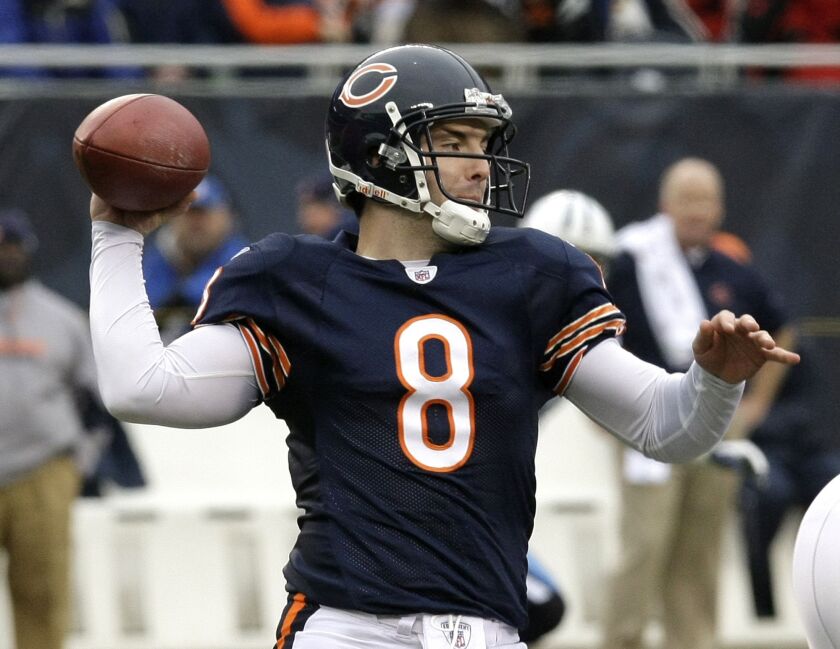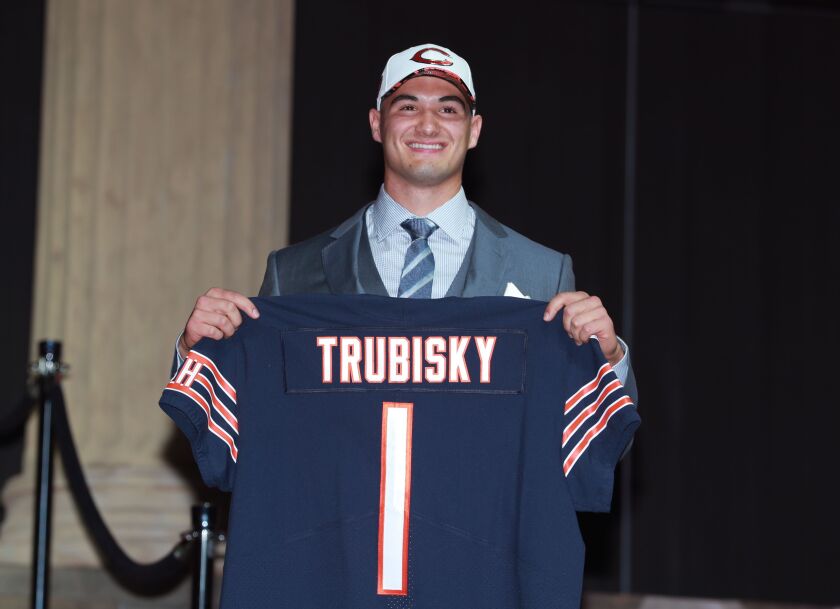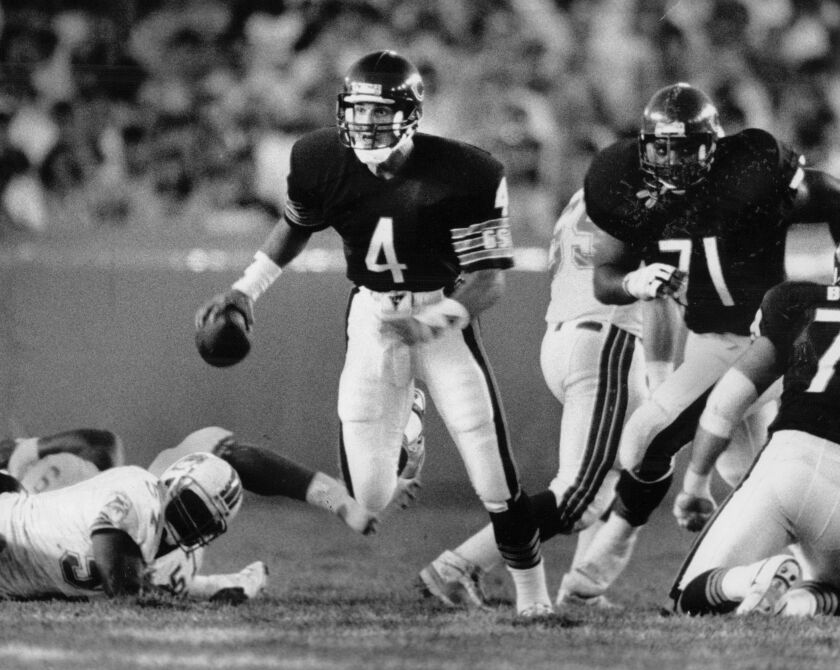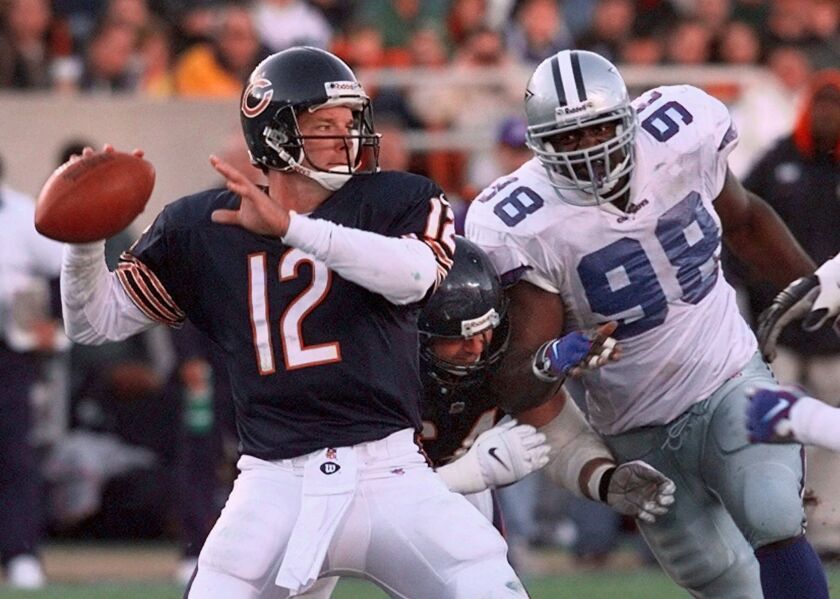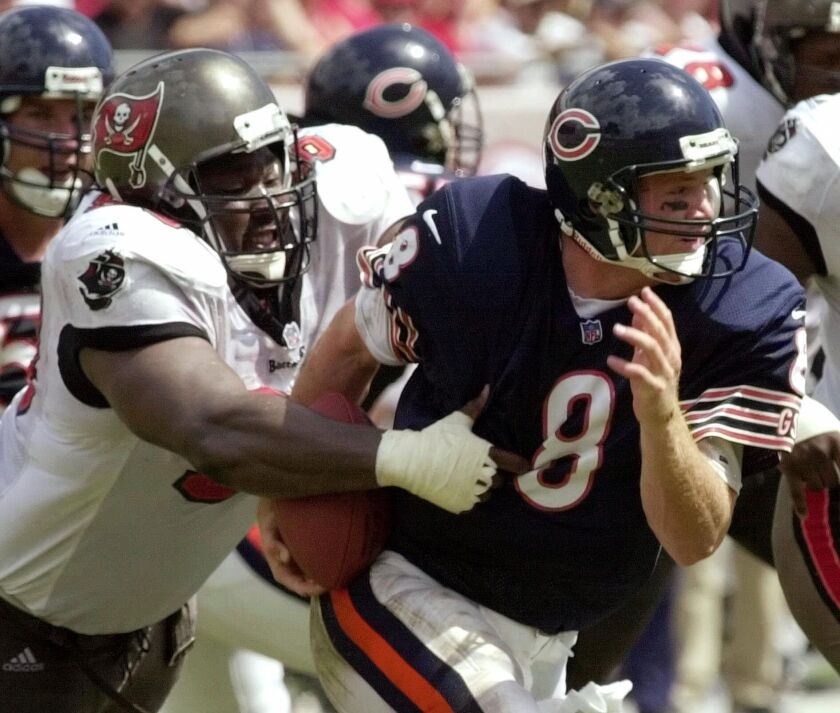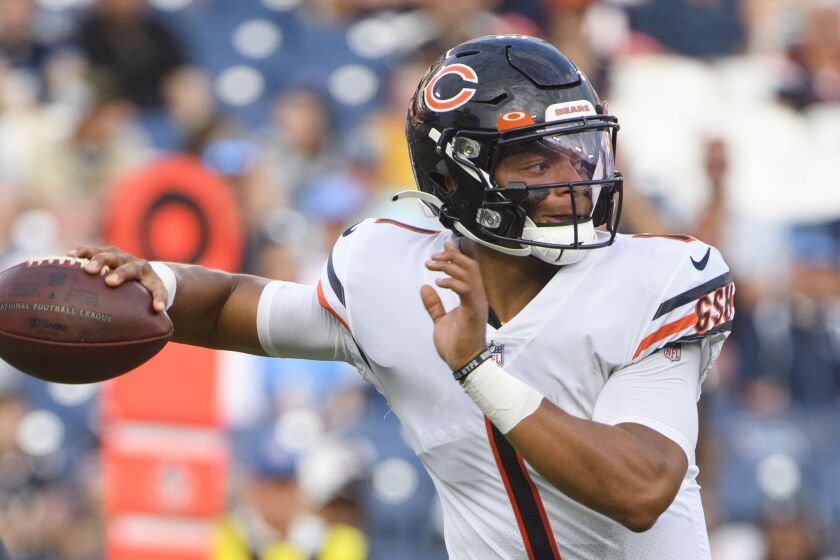The Jay Cutler era was a disappointment and the Mitch Trubisky experience a failure. But neither dubious episode epitomizes the Bears’ desperate search for a quarterback like this one: In 1997, the Bears traded for the worst quarterback in the NFL in search of their franchise quarterback.
It’s true. Rick Mirer’s 56.6 passer rating in nine starts with the Seahawks in 1996 was the lowest in the NFL. The NFL’s co-offensive rookie of the year in 1993, Mirer’s star had dropped so precipitously that he was benched in favor of John Friesz at midseason before regaining the starting job and slumping to the finish. The Seahawks were 2-7 with Mirer starting that season and 5-2 with Friesz and Stan Gelbaugh.
But in Mirer — a former No. 2 overall pick from Notre Dame — the Bears saw hope. And they didn’t just take a flier on a former promising quarterback; they paid a hefty price. They not only traded their first-round pick in the 1997 draft — the 11th overall selection — but they signed Mirer to a three-year, $11.4 million contract, and vice president of operations Ted Phillips reportedly wanted to sign Mirer to a four-year deal. And with Erik Kramer coming off an injury, they promised Mirer the starting job.
What were the Bears thinking?
‘‘All I did [was], I met with [Mirer]. I talked to [then-Seahawks coach] Tom Flores,’’ then-coach Dave Wannstedt recalled. ‘‘What they were doing at Seattle was play-action pass, running the ball, and he could do that. He was an athlete. But as far as the contract and what was given up [in the trade] and what he was paid, I was not involved in that.
‘‘Did I think that he could bring something to our team? Absolutely. I liked him as a person. I thought his personality was good. I thought that he would fit in. That’s how the whole thing evolved.’’
The Bears’ hope that Mirer could recapture the magic of his rookie season — when he set NFL rookie records for most attempts (486), completions (274) and passing yards (2,833) despite a mediocre 67.0 passer rating that ranked 24th in the NFL — evaporated almost instantly as he struggled to grasp their offense under coordinator Matt Cavanaugh, let alone master it.
By the fourth preseason game, Kramer was named the Week 1 starter. Mirer ended up playing in seven games, with numbers that tell the tale: 51.5% completions, no touchdowns and six interceptions for a 37.7 passer rating. In his three starts, he posted ratings of 51.1, 38.4 and 53.6 before he was benched at halftime of a 20-17 loss to the Saints that left Wannstedt’s Bears 0-6.
(At that point, Mirer’s performance was such an embarrassment that Wannstedt had no choice but to replace him. Although, had he stayed with Mirer, the Bears almost surely would have finished with the worst record in the NFL and had a chance to select Tennessee quarterback Peyton Manning in the 1998 draft. Instead, the Bears finished 4-12 — one game worse than the 3-13 Colts.)
‘‘I think it was because we weren’t good enough in other areas to take the pressure off him,’’ Wannstedt said. ‘‘We put him in a situation where he was expected to do more maybe than what we really were hopeful that he’d have to do. We just weren’t good enough around him.’’
The dysfunction that infected the Bears’ front office after the death of owner George Halas in 1983 and the departures of general managers Jim Finks in 1984 and Jerry Vainisi in 1987 played a role in the Mirer failure. The Bears had no GM at the time, relying on personnel director Rod Graves, president Michael McCaskey and Wannstedt to make personnel decisions.
In fact, after Mirer was cut by vice president of player personnel Mark Hatley on the eve of the 1998 season, Wannstedt pinpointed the problem.
‘‘Having a nonexistent pro personnel department at the time,’’ Wannstedt said in August 1998. ‘‘In trying to get as much background on a player as you possibly can in a month’s time, it didn’t give us a chance to be as thorough as we needed to be.’’
The Bears finally created a director of pro personnel position in 1998 — three months after the Mirer trade — when Hatley hired Rick Spielman (now the Vikings’ GM). At the time, however, Graves was handling the work of three or four personnel people, and that led to mistakes.
Mirer himself acknowledged during training camp in 1998 that his 1993 rookie performance misled NFL teams into thinking he was a better quarterback than he was after being the No. 2 overall pick.
‘‘I get more credit for what happened my rookie year . . . and I knew nothing, absolutely nothing,’’ Mirer said. ‘‘I came in [to training camp with the Seahawks] 18 days late, got thrown in there and just played ball. There was no method to our madness.
‘‘There wasn’t enough time for a young, first-time quarterback to understand all the intricacies of that offense, so they didn’t try to. I was told to be athletic and make plays. People don’t understand that. We were dropping back — there’s one receiver and there’s another. Otherwise, run around and make something happen.’’
That scenario in Seattle and the Bears’ desperation for a quarterback became a perfect storm. Sometimes you want a quarterback so badly, it distorts your vision of reality.
‘‘Yeah, that can happen, and that might have been a little part of it,’’ Wannstedt acknowledged in August. ‘‘The Notre Dame connection. The personality. He checked all the boxes in that category. The kid wanted to win.
‘‘I think you can fall into a little bit of a trap, and I’m sure that was an influence because we needed somebody with experience. We didn’t feel like we had time to bring in a rookie and groom him. So you wanted experience and you want a guy that’s going to be athletic and make some plays with his feet. And, obviously, it didn’t work out.’’
***
The Mirer debacle is just one small chapter in the Bears’ search for a franchise quarterback.
Despite winning the NFL championship with Bill Wade in 1963 and the Super Bowl with Jim McMahon in 1985, the Bears’ dearth of quality quarterbacks since Sid Luckman is among the most dubious for any team in any position in sports.
Wade and McMahon are the only Bears quarterbacks voted to the Pro Bowl since 1957 (Trubisky was selected as an alternate in 2018). The Bears haven’t had a quarterback finish among the top 10 in passer rating, yards or touchdowns since Kramer in 1995, when he was fourth in rating (93.5), seventh in yards (3,838) and fourth in touchdowns (29).
Kramer set franchise records for yards and touchdowns that season that still stand (though the Bears finished 9-7 and didn’t make the playoffs). Yet his single-season passing mark (3,838) is eclipsed by every other NFL team and ranks 257th on the all-time list. Kramer’s single-season touchdown record (29) is tied for 157th.
Cutler’s franchise record of 23,443 passing yards is eclipsed by every NFL team but the Texans (who only have been in existence since 2002) and Buccaneers (1976). It ranks 55th in the NFL.
***
The Bears’ search for a franchise quarterback has been one of sports’ ultimate tales of woe. In 1970, the first year of the NFL-AFL merger, the Bears lost a coin flip with the Steelers for the No. 1 overall pick and the right to take Louisiana Tech quarterback Terry Bradshaw.
In 1979, they were reportedly ready to take Notre Dame’s Joe Montana in the third round when Finks — who is deservedly in the Hall of Fame — stepped in at the last minute and took running back Willie McClendon.
In 1997, the Bears (4-12) fell two losses short of the No. 1 pick in the 1998 draft and the chance to take Manning (or Washington State’s Ryan Leaf).
In 1998, the Bears (4-12) fell two losses short of the No. 2 pick in the 1999 draft and the chance to take Mount Carmel graduate Donovan McNabb.
In 2005, when Cal’s Aaron Rodgers was there for the taking, the Bears weren’t interested. They just had drafted Rex Grossman in the first round in 2003, and Grossman was pegged to start by new coach Lovie Smith.
Injuries, bad luck, bad timing and organizational dysfunction all have played a part in the Bears’ inability to find a quarterback who could lead — if not will — a proud franchise to sustained success built on offense.
Rookie Justin Fields — the Bears’ 2021 first-round draft pick (11th overall) from Ohio State — is the latest hope to end the drought. The excitement surrounding Fields has been off the charts. Outside of Cutler, who was coming off a Pro Bowl season when he was acquired in 2009, it’s hard to find a Bears quarterback who has elicited the anticipation of something special happening that Fields has.
But Bears fans conditioned to be disappointed will have to see it to believe it. In that spirit, here is a look at the Bears’ top ‘‘franchise quarterback’’ candidates in the last 40 years:
Jim McMahon (1982-88)
A first-round draft pick (fifth overall) from Brigham Young in 1982, McMahon was the right guy at the right time, even though he was never prolific. In seven seasons, his passer rating was 80.4, with 67 touchdowns and 56 interceptions. Even in 1985, when he finished seventh in the NFL in passer rating (82.6), he was 20th in passing yards (2,392 in 13 games) and 19th in touchdown passes (15).
But McMahon had the ‘‘it’’ factor like no Bears quarterback since Luckman. That never was more evident than in 1985, when he came off the bench in the third quarter against the Vikings and threw three touchdown passes in a span of 6 minutes, 40 seconds to turn a 17-9 deficit into a 30-17 lead en route to a 33-24 victory.
In fact, in the heart of the Mike Ditka era — from Week 11 in 1983 through 1988 — the Bears were 41-6 (.872) when McMahon started. He also led two victories in relief, and he didn’t finish four of the losses because of injury. In the same span, the Bears were 22-11 (.667) when McMahon was out.
Unfortunately, McMahon’s aggressive — and borderline reckless — nature was costly. The only time he played in the postseason when he wasn’t coming off an injury was in 1985, when the Bears dominated the playoffs and won the Super Bowl. He was traded to the Chargers during the preseason in 1989.
Jay Cutler (2009-16)
The celebration over the Bears’ acquisition of Cutler in a trade with the Broncos epitomized the desperation of Bears fans for a franchise quarterback.
The strong-armed Cutler was the best quarterback the Bears had in the Super Bowl era. At 26, he was coming off a Pro Bowl season in which he threw for 4,526 yards and 25 touchdowns. The Bears finally had a quarterback who could put actual fear in a defense.
But even though Cutler played eight seasons with the Bears, it never quite worked out. His fit of petulance that made him available in the first place (he was miffed that new Broncos coach Josh McDaniels attempted to acquire Matt Cassel) was an indication of a quirky, persnickety personality that created conflicts with coordinators and teammates and proved problematic with the Bears.
Cutler had a knack for bad luck, bad breaks and bad timing.
Linebacker Brian Urlacher suffered a season-ending dislocated wrist in the first half of Cutler’s first game with the Bears in 2009. When the Bears reached the NFC Championship Game in 2010, Cutler suffered a mysterious knee injury in the first half of a 21-14 loss to the Packers at Soldier Field. When he finally had a quarterback whisperer in Marc Trestman, the defense fell to 30th in the NFL in 2013 and 2014.
He was beset at various times by poor protection, a less-than-stellar receiving corps and coaching changes, but he also was his own worst enemy, with a knack for committing ill-timed turnovers.
And the one time he had almost everything going his way — in 2013, when Trestman was the head coach, with a full complement of weapons in Matt Forte, Brandon Marshall, Alshon Jeffery and Martellus Bennett and an offensive line that started the same five players for 16 games — Cutler still was only 13th in the league in passer rating (89.2), 17th in yards per game (238.3), 12th in completion percentage (62.1) and 10th in yards per attempt (7.4). And when he suffered an injury, journeyman Josh McCown outplayed him, with a 109.0 passer rating (12 touchdowns, one interception) in eight games.
Cutler broke Luckman’s franchise records for passing yards (23,443) and touchdowns (154) and nearly doubled Wade’s record of nine 300-yard games (16). But when he was cut after the 2016 season, his legacy was more one of regret than of celebration.
Rex Grossman (2003-08)
When the Bears drafted Grossman with the 22nd overall pick in 2003, they had no intention of starting him as a rookie and there was little to no debate. The Bears had signed established starter Kordell Stewart in free agency, and that was that.
Grossman was named the starter in 2004, when Smith replaced Dick Jauron. He showed flashes of being a franchise quarterback and still is the only Bears quarterback, other than McMahon, to play in the Super Bowl. But he lacked the durability and consistency to put it all together.
Injuries limited Grossman to three starts in 2004 and two in 2005. His 2006 season told the tale: Grossman was an MVP candidate as the Bears started 7-0, but he couldn’t sustain it and developed the Good Rex/Bad Rex persona that he never could shake.
Grossman had ratings of 148.0, 137.4, 114.4, 105.7 and 104.3 (a combined 14 touchdowns and one interception), but he also had ratings of 0.0, 1.3, 10.2, 23.7 and 36.8 (a combined one touchdown and 16 interceptions). With possession and a chance to take the lead early in the fourth quarter of Super Bowl XLI, he threw an interception that Colts cornerback Kelvin Hayden returned 56 yards for a touchdown.
Grossman was benched in favor of Brian Griese three games into the 2007 season and was beaten out by Kyle Orton in 2008 before the Bears decided to move on and eventually traded for Cutler in 2009.
Mitch Trubisky (2017-20)
The draft-night trade that brought Trubisky to Chicago hovered over his ill-fated Bears tenure like a dark cloud.
Not only did GM Ryan Pace trade three draft picks to move up one spot — from No. 3 overall to No. 2 — to get Trubisky, but his fixation on him overlooked two better quarterbacks: Clemson’s more proven Deshaun Watson and Texas Tech’s Patrick Mahomes, who quickly became a sensation with an MVP and Super Bowl ring in his first three seasons.
Though missing out on Mahomes and Watson was almost immediately regrettable, Trubisky showed flashes of being an eventual hit in 2018, when Matt Nagy replaced John Fox as head coach. Trubisky threw six touchdown passes against the Buccaneers, had six 100-plus passer ratings and made the Pro Bowl as an alternate.
But, like Grossman before him, Trubisky was dogged by inconsistency and a lack of instinct for the position. He struggled to read defenses, most of his good games came against subpar defenses and he lost his knack for running that made his 2018 season promising.
He was benched in 2020, regained the job and led an offensive surge that carried the Bears into the playoffs. By then, however, Nagy and the Bears had seen enough, and Trubisky was let go and signed with the Bills as a backup for 2021.
Jim Harbaugh (1987-93)
The Bears selected Harbaugh as their quarterback of the future — in the first round of the 1987 draft out of Michigan — when they were still riding the high of the Ditka era.
By the time he became the full-time starter in 1990, the championship window was closing rapidly. Harbaugh had toughness, heart and resilience. But in a Ditka offense built around the run, he never developed into anything more than a complementary piece.
Harbaugh’s best chance for success came in 1990, when the Bears were 10-2 and Harbaugh was fifth in the NFC in passing (88.2 rating, 10 touchdowns, four interceptions). But he was playing through injuries — a fractured rib, a bruised sternum, a strained hamstring — and the wear and tear caught up with him when he suffered a separated shoulder against the Lions in Week 15 that ended his season.
With Harbaugh at quarterback in 1991, the Bears went 11-5 and lost to the Cowboys 17-13 in the playoffs. That was pretty much it. The wheels came off in 1992, when Ditka berated Harbaugh after his audible led to a pick-six in a dreadful 21-20 loss to the Vikings.
By the time Wannstedt took over the next season, Harbaugh was still the starter, but he had no future in Chicago. He finished with a 35-30 record and 74.2 passer rating (50 touchdowns, 56 interceptions).
‘‘Jim had no help,’’ Wannstedt said of that 1993 season. ‘‘There were issues with management and Jim. And fans — I remember our very first preseason game, they introduced the offense, and there was a percentage of fans at Soldier Field that booed our offense with Jim. . . . It could have been Aaron Rodgers and it would have been a tough situation because we just didn’t have the supporting cast around him that we needed.’’
Erik Kramer (1994-98)
A free-agent signing in 1994 (three years, $8.1 million), Kramer had the best season of any Bears quarterback in the Super Bowl era in 1995. He set franchise records for passing yards (3,838) and touchdown passes (29) that still stand today. He was fourth in the NFL in passer rating (93.5).
Kramer wasn’t flashy, but he was efficient and unflappable. He was just the guy Wannstedt was looking for in a long-term quarterback.
‘‘Absolutely,’’ Wannstedt said. ‘‘Erik Kramer could do everything that we asked him to do.’’
Unfortunately, after starting all 16 games in 1995, Kramer couldn’t stay healthy. He suffered a season-ending herniated disc in his neck in Week 4 in 1996. He was on pace for more than 3,600 passing yards midway through the 1998 season before suffering a shoulder injury that eventually ended his season.
‘‘Injuries, injuries, injuries,’’ Wannstedt said. ‘‘If Erik stays healthy, we’ve got a chance.’’
After Wannstedt was fired following the 1998 season and replaced by Jauron, Kramer was the Bears’ No. 1 quarterback heading into training camp. But he was cut on the eve of camp, clearing a path for first-round rookie Cade McNown to battle for the starting job. And Kramer left with an ominous warning:
‘‘If you’re a parent and your 14-year-old kid comes home with a straight-A report card, that doesn’t mean you give him the keys to the car.’’
Cade McNown (1999-2000)
Unable to get quarterbacks who went 1-2-3 overall in the draft (Tim Couch, McNabb and Akili Smith), Hatley traded down from No. 8 to No. 12 to take McNown, a punky QB from UCLA.
McNown got off to a bad start with a 10-day holdout that dented his chances to win the starting job. (As it turned out, he held out for ‘‘voidable years’’ that he never would see).
It was all for naught, anyway. McNown had talent and gumption and a playmaker’s knack, but he lacked the maturity and polish needed to put it all together. He had his moments as a rookie — three touchdown passes in relief of an injured Shane Matthews against Washington and four touchdown passes to Marcus Robinson in a start against the Lions — but he was ill-prepared, and it showed.
McNown began the 2000 season as the starter and was mostly mediocre before suffering a separated shoulder at midseason. When he returned against the 49ers in Week 15, his miserable, uninterested performance in a game in which the Bears never crossed midfield all but sealed his fate. He was traded to the Dolphins the next preseason but never appeared in another NFL game.
Justin Fields (2021-)
Just when it looked like the misevaluation of Trubisky was going to define his tenure in Chicago, Pace made a sudden bold move in the 2021 draft that invigorated the franchise. He traded a first-round draft pick in 2022 to move up from No. 20 to No. 11 overall to take Fields.
Unlike the Trubisky pick, which was panned by many analysts from the minute it was made, the selection of Fields was heralded as a masterstroke. While Fields was the fourth quarterback taken in the draft — behind Trevor Lawrence (Jaguars), Zach Wilson (Jets) and Trey Lance (49ers), who went 1-2-3 — he was rated in their class by many draft analysts and behind only Lawrence by some of them.
And Fields came with better credentials than Trubisky did in 2017: a 20-2 record at Ohio State and a standout performance in a victory against Clemson in the College Football Playoff semifinals.
The Bears immediately put Fields on an apprenticeship program, planning for him to sit and learn behind veteran Andy Dalton in 2021, just as Mahomes sat behind Alex Smith when Nagy was with the Chiefs in 2017.
Time will tell whether that plan will hold up. Fields has looked the part of a quarterback of the future in early camp practices, showing off a strong arm, quick feet and a sudden burst as a runner. There’s a long way to go, but Fields already has provided the franchise and Bears fans with more hope for a franchise quarterback than they’ve had in a long time.
FRANCHISE CAREER PASSING LEADERS
Jay Cutler’s Bears franchise record for career passing yards (23,443) is lower than the record of all but two NFL franchises — the Texans (who joined the NFL in 2002) and the Buccaneers (1976):
Tom Brady, Patriots 74,571
Drew Brees, Saints 68,010
Brett Favre, Packers 61,655
Dan Marino, Dolphins 61,361
Ben Roethlisberger, Steelers 60,348
Philip Rivers, Chargers 59,271
Eli Manning, Giants 57,023
Matt Ryan, Falcons 55,767
Peyton Manning, Colts 54,828
John Elway, Broncos 51,475
Matthew Stafford, Lions 45,109
Joe Flacco, Ravens 38,245
Jim Kelly, Bills 35,467
Joe Montana, 49ers 35,124
Jim Hart, Cardinals 34,639
Tony Romo, Cowboys 34,183
Russell Wilson, Seahawks 33,946
Warren Moon, Oilers/Titans 33,685
Fran Tarkenton, Vikings 33,098
Donovan McNabb, Eagles 32,873
Ken Anderson, Bengals 32,838
Cam Newton, Panthers 29,041
Len Dawson, Chiefs 28,507
Joe Namath, Jets 27,057
Derek Carr, Raiders 26,896
Mark Brunell, Jaguars 25,698
Joe Theismann, Washington 25,206
Jim Everett, Rams 23,758
Brian Sipe, Browns 23,713
Jay Cutler, BEARS 23,443
Matt Schaub, Texans 23,221
Jameis Winston, Buccaneers 19,737
FRANCHISE LEADERS: SINGLE-SEASON PASSING YARDS
Erik Kramer’s Bears single-season record of 3,838 passing yards, which he set in 1995, is the lowest single-season franchise mark in the NFL. It ranks 257th on the NFL’s all-time list:
Peyton Manning, Broncos 5,477
Drew Brees, Saints 5,476
Tom Brady, Patriots 5,235
Ben Roethlisberger, Steelers 5,129
Jameis Winston, Buccaneers 5,109
Patrick Mahomes, Chiefs 5,097
Dan Marino, Dolphins 5,084
Matthew Stafford, Lions 5,038
Matt Ryan, Falcons 4,944
Eli Manning, Giants 4,933
Kirk Cousins, Washington 4,917
Tony Romo, Cowboys 4,903
Kurt Warner, Rams 4,830
Deshaun Watson, Texans 4,823
Dan Fouts, Chargers 4,802
Andrew Luck, Colts 4,761
Daunte Culpepper, Vikings 4,717
Warren Moon, Oilers/Titans 4,690
Rich Gannon, Raiders 4,689
Jared Goff, Rams 4,688
Carson Palmer, Cardinals 4,671
Aaron Rodgers, Packers 4,643
Josh Allen, Bills 4,544
Steve Beuerlein, Panthers 4,436
Blake Bortles, Jaguars 4,428
Joe Flacco, Ravens 4,317
Jeff Garcia, 49ers 4,278
Russell Wilson, Seahawks 4,219
Brian Sipe, Browns 4,132
Carson Wentz, Eagles 4,039
Joe Namath, Jets* 4,007
Erik Kramer, BEARS 3,838
* 14-game season



